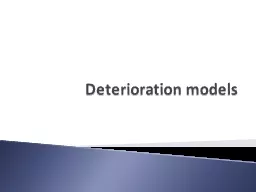

For any asset A deterioration model can be constructed Predictions can be made regarding asset conditions without the need to carry out the CA survey which is Time consuming and Very expensive if done at microscopic level ID: 613133
Download Presentation The PPT/PDF document "Deterioration models" is the property of its rightful owner. Permission is granted to download and print the materials on this web site for personal, non-commercial use only, and to display it on your personal computer provided you do not modify the materials and that you retain all copyright notices contained in the materials. By downloading content from our website, you accept the terms of this agreement.
Slide1
Deterioration modelsSlide2
For any asset
A deterioration model can be constructed ,
Predictions can be made regarding asset conditions without the need to carry out the CA survey, which is,Time consuming and Very expensive if done at microscopic levelMain issues with the construction of deterioration modelTime consuming processRequires lots of data Trial and errorA lot of testing and validation need to be carried out
Importance of deterioration modelSlide3
So far only two fields of study has comprehensive deterioration models;
Bridge and
PavementModel constructionComplex mathematical modelsMarkov chainsBayesian models, amongst others.Deterioration modelsSlide4
AM stagesSlide5
Tabulating assets in order of defined criticality
Option 1
Most defective asset ranked first and the rest follows with the last asset being the one requiring less attentionOption 2Less defective asset ranked first and the rest follows with the last asset being the one requiring more attentionPrioritization of assetsSlide6
Prioritization of assets
Printer ID
Remaining Service LifeCost to Maintain/repair/rehabilitate
Rank after Prioritization
PC0012
2
2,100
PC1120
3
3,090
PC0022
3
2,100
PC1102
1
1,500
PC2220
0
0
PC0007
3
1,500
PC0029
0
0Slide7
Benefit Cost Analysis
(BCA)Slide8
BCA - systematic evaluation of the economic advantages (benefits) and disadvantages (costs) of a set of investment alternatives.
Base case is mandatory
Alternatives – betterment optionsAlternatives are compared to base case.A benefit-cost analysis tries to answer the question: What additional benefits will result if this Alternative is undertaken, and what additional costs are needed to bring it about? IntroductionSlide9
In the past, Asset managers were using engineering concepts solely for decision making with respect to which asset need to be repaired/rehabilitated or renew first.
Now apart from engineering concepts, they are also using economic theories – when they try to justify their investments – rate of return for every money spent.
BCASlide10
Our agency, in this example, is managing highways.
What
kind of benefits will be produced by improving highways? What are the Costs required to bring about the betterment/improvement.BCA example - Highway systemSlide11
BenefitsTravel time savings
VOC
Safety benefitsCostsThe value of the resources that must be consumed to bring the project about. Capital costsMajor rehabilitation cost – over 20 years – analysis periodRoutine annual maintenance costsRemaining capital value – salvage value
BCA example - Highway systemSlide12
For most transportation
investments
costs are incurred in the initial years – short termwhile the benefits from the investment accrue over many years into the future – long-termWhen assessing the costs and benefits of a project, it is necessary to take into account the time value of money by converting the costs and benefits that take place in different years into a common year. This process is known as
discounting and converts
future costs and benefits that occur in different years into a value for a common year (present value).
BCA example - Highway systemSlide13
The present value (PV) of a future cost or benefit can be determined using the formula:
PV =
AByi(1 + r)(yi-yo) Where: PV = present value AB (or AC) = annual benefit (or annual cost)
r = the discount rate
y
i
= the year in which the benefit or cost occurs
y
o
= the year of analysis (i.e., the year to which the future dollars are discounted)
BCASlide14
After
the future streams of costs and benefits are discounted, the sum of the discounted benefits is divided by the sum of the discounted cost. This can be represented by the following formula:
B/C = PV(Benefits) /PV(Costs) B/C = Benefit-cost ratio PV(x) = Present Value of x If the result is greater than or equal to 1.0, the infrastructure improvement is economically justified. Benefit cost ratioSlide15
5 groupsList the benefits and costs that you believe will help in determining the BC of the asset. Justify your answers.
Class exercise
Group #
Asset
1
Printers
2
Computers
3
Software
4
Bridges
5
RoadsSlide16
For what type of assets would you consider building deterioration models?
Discussion Topic